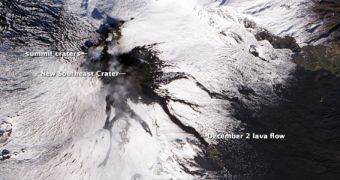Recent orbital surveys of Mount Etna, in eastern Sicily, Italy reveal new signs of activity at this dangerous volcano, which is renowned for its powerful eruptions. The image above was collected using the Operational Land Imager (OLI) instrument aboard the Landsat 8 spacecraft.
The satellite is the result of collaborative effort established between NASA and the US Geological Survey (USGS), and is part of the Landsat constellation of Earth-monitoring spacecraft. Its instruments were designed specifically for this type of observations.
According to this natural-color photograph, lava was deposited on the slopes of the 3,350-meter (10,991-foot) stratovolcano less than 11 days ago. The most likely culprit is the New Southeast Crater, which erupted for a short while on Saturday, December 14.
The reason why this volcano is so active is that it lies at the junction of the African and Eurasian tectonic plates, both of which are very large, and pretty much trying to get to where they are going, passing through each other. These frictions cause intense volcanic activity in the area.

 14 DAY TRIAL //
14 DAY TRIAL //